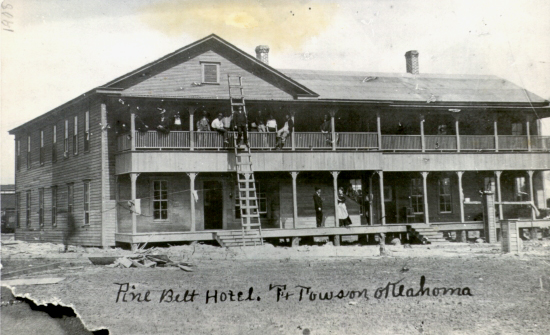The Encyclopedia of Oklahoma History and Culture
FORT TOWSON.
The town of Fort Towson took its name from the nearby fort, named for Nathan Towson, an army paymaster. The town is located on U.S. Highway 70, eleven miles east of Hugo in Choctaw County. Such notable historical characters as Sam Houston and Gen. Winfield Scott had visited the fort in the Indian Territory era. A thriving community called Doaksville was located one mile west of the fort site. In 1902, when the Arkansas and Choctaw Railway reached eastern Choctaw County, a group of two hundred male citizens submitted a petition proposing the purchase of 160 acres of land for a townsite near the fort. The location was desirable because Boiling Springs, on the site's northern edge, provided an artesian spring that ran into Gates Creek. The survey having been finished in December 1902, Thomas Ryan, acting secretary of the interior, completed the approval. Among early residents were William and Tinsley Pryon, Jordon Folsom, D. G. Ball, and Wright Hopson.
During the 1900s the lumber industry became prominent in the surrounding region. Wright Hopson bought timber rights and sold them to the Pine Belt Lumber Company. In addition to the lumber company sawmill, various businesses, including a bottling works, sweet potato drying plant, cotton gin, two banks, two hotels, and several boarding houses made Fort Towson a commercial hub for the east end of the county. The 1910 population registered at 697 residents. In 1923 fifty more acres were added to the town. This was called the Old Fort Addition, and later another fifty acres constituted the West Fort Towson Addition. The 1930 population stood at 486.
Thomas Fennell built the first post office and served as the town's first postmaster. The Fort Towson post office has been recognized as one of the oldest continually operating post offices in the state. The Fort Enterprise began publication in 1905. Col. Charles C. Lewter owned and operated the newspaper, which came out each Friday through World War I, and then he sold it to a Hugo newspaper. Doaksville Lodge 279, which meets at Fort Towson, was one of the earliest Masonic lodges in Oklahoma, beginning in 1852. Many Oklahoma showmen, rodeo performers, and circuses made the area their home.
In 1940 the town boasted a population of 501, and the decade provided several years of "all women" town councils. In the late 1950s Gov. Raymond Gary kept a campaign promise and authorized the creation of Lake Raymond Gary and the accompanying state park. The Gates Creek Dam Association was formed and sold some four hundred memberships to begin and support the effort. Randle Swink, president, and local merchant O. B. Medford, secretary, spearheaded the movement. In 1979 the town extended its limits to include lake residents. In 1980 the population stood at 789; by 2000 it had dropped to 611 and by 2010 to 519. At the beginning of the twenty-first century the Lake Raymond Gary Association provided fireworks on the lake each Fourth of July and a spectacular lighted boat parade at Christmas. The Fort Towson Historical Society Museum, on the west end of the new town hall, chronicles the town's pioneer history through the twentieth century. In April 2020 the census reported 496 residents.
Learn More
Marlynn Fleck-O'Keefe, Fort Towson, Indian Territory: A Link to the West (Fort Towson, Okla.: Lakeside Publications, 1997).
George H. Shirk, Oklahoma Place Names (2d ed.; Norman: University of Oklahoma Press, 1974).
Related Resources
Citation
The following (as per The Chicago Manual of Style, 17th edition) is the preferred citation for articles:
Marlynn Fleck O'Keefe, “Fort Towson (town),” The Encyclopedia of Oklahoma History and Culture, https://www.okhistory.org/publications/enc/entry?entry=FO045.
Published January 15, 2010
Last updated March 1, 2024
© Oklahoma Historical Society


